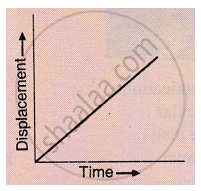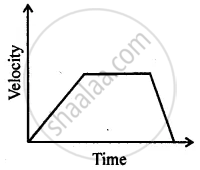Advertisements
Advertisements
प्रश्न
Multiple choice Question. Select the correct option.
The speed of a car reduces from 15 m/s to 5 m/s over a displacement of 10 m. The uniform acceleration of the car is :
विकल्प
−10 m/s2
+10 m/s2
2 m/s2
0.5 m/s2
उत्तर
−10 m/s2
Explanation:
Initial velocity = u = 15 m/s
Final velocity = v = 5 m/s
Displacement = S = 10 m
Acceleration = a = ?
v2 – u2 = 2aS ;
(5)2 – (15)2 = 2a (10)
25 – 225 = 20a
a = −220/20 = -10 ms−2
APPEARS IN
संबंधित प्रश्न
A train starting from a railway station and moving with uniform acceleration attains a speed 40 km h−1 in 10 minutes. Find its acceleration.
Fill in the following blank with suitable word :
A motorcycle has a steady……………. of 3 m/s2. This means that every………………. its…………….. increases by………….
What conclusion can you draw about the velocity of a body from the displacement-time graph shown below :

Name the quantity which is measured by the area occupied under the velocity-time graph.
Explain why, the motion of a body which is moving with constant speed in a circular path is said to be accelerated.
A body starting from rest travels with uniform acceleration. If it travels 100 m in 5 s, what is the value of acceleration ?
A train starting from stationary position and moving with uniform acceleration attains a speed of 36 km per hour in 10 minutes. Find its acceleration.
A car acquire a velocity of 72 km per hour in 10 second starting from rest. Find
(1) the acceleration,
(2) the average velocity, and
(3) the distance travelled in this time.
A bus increases its speed from 36 km/h to 72 km/h in 10 seconds. Its acceleration is :
Can you suggest a real-life example about the motion of a body from the following velocity – time graph?

